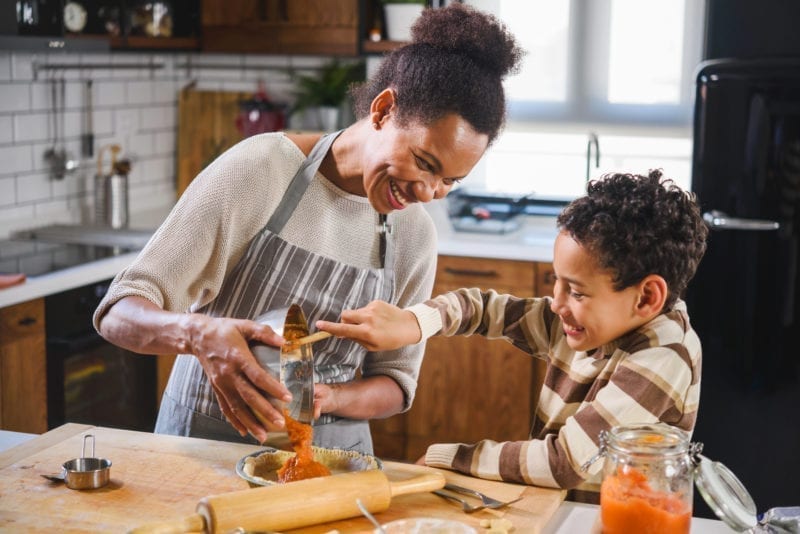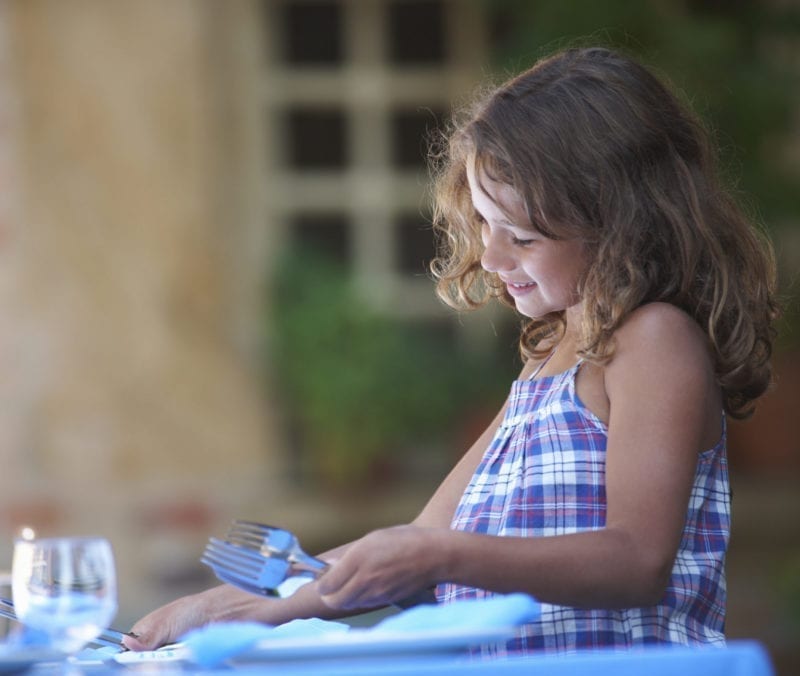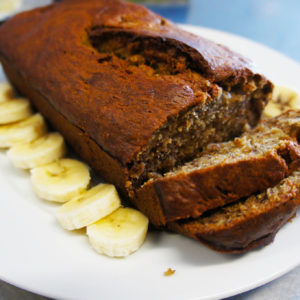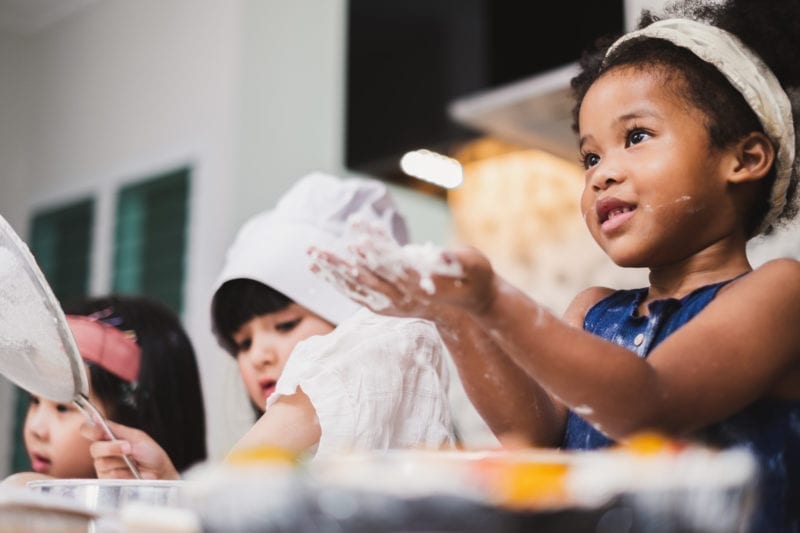Ever notice how the kitchen is always the best room at a party? The kitchen is the true center of the home. For many of us, the kitchen even doubles as a work and study space.

Now that a huge part of the world is hunkering down at home, the place we’re most likely to find ourselves is probably in the kitchen. If you’re like me, you might even take solace in some anxiety baking. Apart from learning Spanish, my kids and I are perfecting an epic banana bread recipe. (They like the fact that banana bread is actually banana cake with a misleading name. 😊) I’ll share our Epic Banana Bread recipe at the end of the article!
Beyond culinary creativity, the kitchen is also a great source of inspiration for language learning. Foods are easy to remember. Our minds store them in multiple sensory categories, like taste and smell. Names of foods often cross languages, like pizza and chow mein. Dishes and utensils are tactile and ubiquitous.
There are countless opportunities for language learning with our kids while we’re preparing food, washing dishes, setting tables, making lists and buying groceries.
Here are six ways to practice a new language with your kids in the kitchen.
1. Making Grocery Lists
Make your shopping list together with your kids. How many of the foods on the list can you say in your new language? Practice these sentences:
Q: “What do you want to eat?” “¿Qué quieres comer?”
A: “I want to eat banana cake!” “Quiero comer torta de banana.”
Q: “What does your sister want?” “¿Qué quiere tu hermana?”
A: “She wants banana cake too!” “¡Ella también quiere comer torta de banana!”
2. The Mystery Missing Item
Take six food items out and put them on the table. Practice saying each item in the new language. Your kids should then turn around and look away while you remove one item and hide it. When they look back, they must guess what’s missing and say it in the new language. Put the food back. Take turns hiding one item while the others try to discover what’s missing. You can also play this with place settings and (unbreakable) dishes.
3. Pass the Silverware
 Dishes and utensils are a great thing to know in a new language. Each time your kids set the table, wash the dishes, load the dishwasher or put dishes away, they can be practicing the names for each item in their new language.
Dishes and utensils are a great thing to know in a new language. Each time your kids set the table, wash the dishes, load the dishwasher or put dishes away, they can be practicing the names for each item in their new language.
Here is a game you can play when seated around the kitchen table: Take out forks, spoons, chopsticks and butter knives. Practice first. Send each item around the circle of people one at a time. Each person should say the item as they pass it. Give everyone a few different items so that no one has the same combination. Someone has a fork and spoon, someone has a knife and spoon, someone has a fork and knife, etc. Say one item out loud: “Fork!” Start counting down from 10. Everyone with a fork should say: “I have it!” in their new language.
4. Little Helpers – Bring me the butter!
Baking is a great way to calm your mind, focus your energy and create something lovely to look forward to. It’s also a great time to practice saying different ingredients and utensils in a new language.
Prepare a recipe, like Epic Banana Bread for example 😃! Get your kids to be your helpers – with a twist – they’ll have to understand some of the ingredients or implements in their new language.
Practice these simple sentences in their new language while you cook:
“We need a bowl.” or “Please get two eggs.”
“Necesitamos un tazón.” o “Consigue dos huevos, por favor.”
5. Draw a Menu
Get out coloured pencils and paper. Use a ruler to make a grid on the paper with boxes that are big enough for your kids to draw inside. Have them draw different food in each box. Practice saying each food in their new language. They can even add prices! The kids can then use these menus to play make-believe “restaurant” at the table while you prepare dinner.
6. Food Cards – Yummy or Yucky Game
Have your kids draw different food, drinks, fruit or vegetables on notecards, as many different food items as they can. Two dozen makes a good deck. You can write the names of the food items in their new language for reference if you want, however, it’s better for new language learners not to read before they can speak.
The game is played in rounds. Each person takes a turn as the judge. The judge deals out the food cards, four cards per person. Everyone pairs two food cards from their hand and tries to make either the most delicious or the most disgusting combination. The judge awards one point for the most delicious and one point for the most disgusting combination. Shuffle the cards and go again! Try this sentence in the new language if you know it:
Player: “Do you like….ice cream soup?” “¿Te gusta la sopa de helado?”
Judge: “Yum! Delicious!”
Player: “Do you like pizza with candy?” “¿Te gusta la pizza con dulces?”
Judge: “Yuck! Disgusting!”
I’ll be spending a lot of time in the kitchen with my kids these days – cooking, cleaning and learning at the table. My kids speak English and Chinese. As I said, their new language is Spanish! My Spanish level is beginner, but I do remember a few things, so I’ll be doing my best with the help of Google translate and our company, Studycat’s, Fun Spanish app.
Our apps teach lots of different food, so I’m having the kids play those games first to prepare for cooking with Dad! Getting familiar with vocabulary before you use it is called flipped classroom by the way.
And now….Here is our Epic Banana Bread recipe: (The Epic part is the thick layer of melted bananas in the middle!)
Epic Banana Bread
- 2 ¼ cups of almond flour
- ¼ cup of tapioca or yam flour
- ¼ teaspoon of baking soda
- ¼ teaspoon of salt
- 2 tablespoons of coconut oil
- ½ cup of brown sugar
- 2 eggs
- 4 bananas
- 1 tablespoon of vanilla
- 1 teaspoon of cinnamon
- Stir dry ingredients in one bowl: almond flour, tapioca flour, baking soda, salt and cinnamon.
- Mix brown sugar, oil, 2 bananas and vanilla in another bowl. Then beat in two eggs.
- Combine the two bowls.
- Pour half the batter into a deep cake or bread pan.
- Slice the 2 remaining bananas on top.
- Add the rest of the batter to cover the banana slices up.
- Bake it at 375F for 25 -30 minutes until it’s carmelly brown.
- Cool, slice, gobble, repeat.
The next installment of this series will be How to Practice a New Language with your Kids in the Bathroom!
Until then, my friends.



